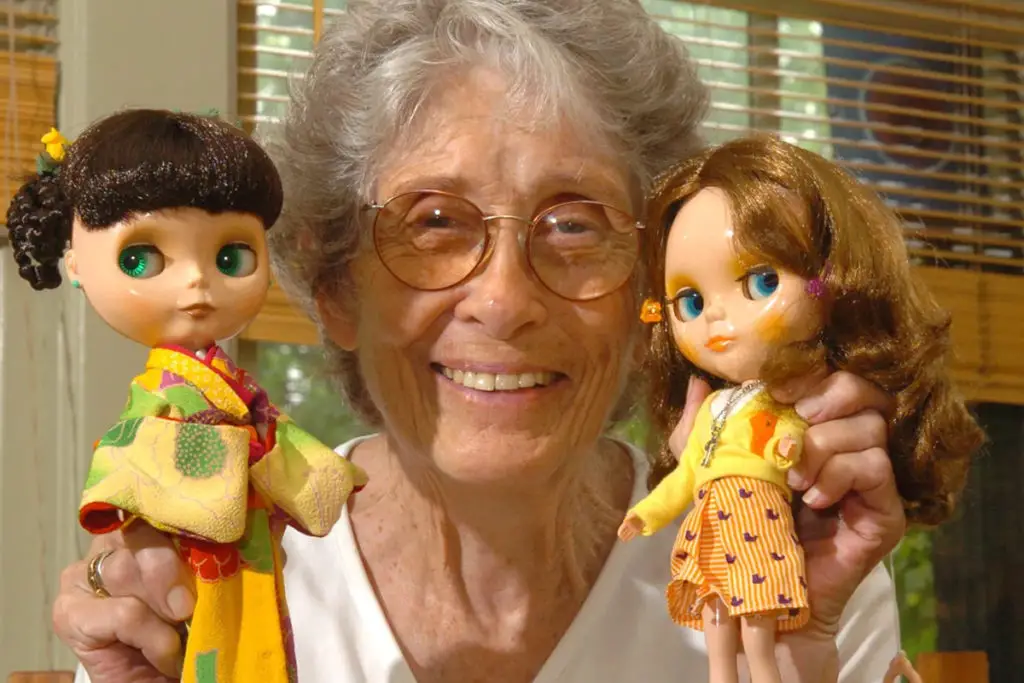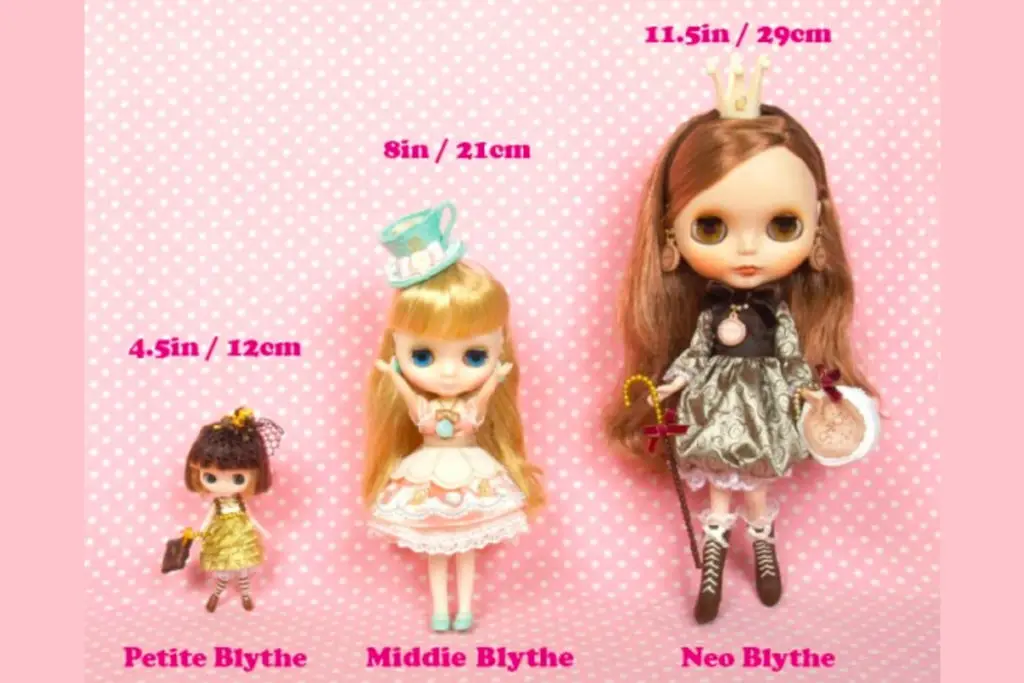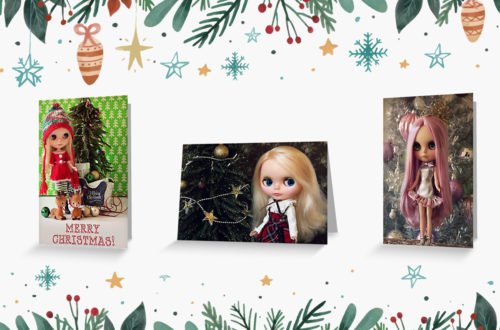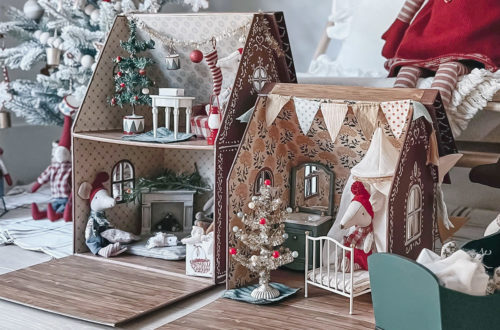
What is a Blythe doll?
Welcome to the intriguing story of Blythe dolls! Maybe you’ve come across the term ‘Blythe doll’ in doll forums or have seen a rather interesting looking doll called Blythe on ebay and asked yourself ‘what is a Blythe doll?’. She is a bit of an enchantress with a chequered past so be warned…you might end up buying 20 Blythe dolls in a short amount of time once you fall under her spell. And especially watch out for those Kenners. If you see one in real life, shield your eyes so you don’t catch ‘Kenner fever’.
Of course I am joking (kind of). I have in the past fallen hard for Blythe and dented my bank account checking off my wishlist. I have also suffered from a bad case of Kenner fever after an in-person meetup with other Blythe collectors and bought two on ebay a week later (ouch!). As you will discover, if you are brave enough to read on, Blythe dolls aren’t cheap.
Let’s first cover the basics of ‘what is a Blythe doll?’.
A ‘Blythe doll’ generally refers to a Neo Blythe doll (more about that later). She is similar in height to a Barbie doll, standing at 28cm (11½”) tall. The most noticeable features of Blythe are 1) her disproportionately massive head and 2) her kooky eyes that can change color. Her large head makes her top heavy so she cannot stand on her own.
Blythe’s hair is generally made from saran (similar to Barbie’s) and is rooted to a scalp. Unlike Barbie’s painted eyes though, Blythe’s eyes are made from translucent plastic chips. To change Blythe’s eye color, a string is pulled to work a mechanism inside her head that contains four sets of different colored eye chips (I can’t understand why children were scared 😀 ).
What scale are Blythe dolls?
Since Blythe dolls are the same height as Barbie dolls, they are referred to as 1:6 scale. Barbie furniture and dollhouses tend to also work well for Blythe’s size.
But how can she be the same size as Barbie with such a large head? Where Barbie has long legs and torso, Blythe dolls have shorter legs and shorter, more girlish, bodies (unlike Barbie’s more ‘womanly’ body). They are similar in body size to Skipper dolls and vintage Skipper clothes are sought out by Blythe doll collectors. If you are familiar with Japanese Licca-Chan dolls, Blythes have very similar bodies to them.
Who made the original Blythe doll?
The original Blythe doll was designed by Allison Katzman, an American toy designer, in the 1970s and released by Kenner toy company in 1972. Blythe’s original look was inspired by Betty Boop and she was marketed as an alternative to Barbie dolls for young girls. Unfortunately, her big head and strange eyes that changed color scared the children so her release was a flop and she was removed from the market that same year.
I guess we modern day collectors can be thankful that so many were left unplayed with and abandoned to attics still in their boxes. When you come across the term ‘Kenner Blythe’ it is referencing one of these original 1972 dolls.

The original Kenner Blythe dolls had four different hair color options, some with different hair styles as well:
- Blonde sidepart with no bangs (fringe)
- Raven with center part and wispy bangs
- Brunette with either chunky bangs, center part with wispy bangs, or sidepart with no bangs
- Redhead with either chunky bangs, center part with wispy bangs, or sidepart with no bangs.
They each came in different colored boxes and with different outfits depending on their hair color.
At some point during production in 1972, Kenner changed the identifying text on the back of Kenner Blythes. Early releases have six lines of text, later releases have seven lines. When a Kenner Blythe doll is for sale you will often see this mentioned as collectors sometimes want a particular version to complete their collection. I have owned both six and seven line blonde sidepart Kenners.
In Australia, Kenner licensed the sale of Blythe dolls to Toltoys. I was lucky enough to own a blonde sidepart Australian Toltoys Kenner doll.
If you are curious about Kenner Blythe dolls, a US collector has put together a Kenner Blythe Guide website.
Allison Katzman passed away in 2020 at the age of 95. Thankfully before she passed she was able to witness how much Blythe is loved by collectors now. In 2006 she visited a Blythe convention in Tokyo and the attendees bowed to her. She also attended some of the US Blythecons as a guest of honor.
What is a Neo Blythe doll?
So what happened next for Blythe? You now know about Kenner Blythe dolls but may have heard the term Neo Blythe doll. What on earth are they? Sounds very Matrix 😀
After more than 20 years of oblivion, in 1997 a New York photographer, Gina Garan, received an original Kenner Blythe doll as a gift. Gina began practising her photography skills on Blythe and discovered how photogenic that big head and those crystalline plastic eye chips are. She released a book called ‘This is Blythe’ full of beautifully dressed and posed Blythes in outdoor and indoor scenes.
The book was noticed by toy producer, Junko Wong, at an event in New York. Junko is the director of CWC, the company that designs modern Blythes. Junko could see the potential for Blythe in the Japanese market. (There was a follow up photography book by Gina Garan called Blythe Style.)
In 2001 the first new (‘neo’) Blythe was released for the department store, Parco. They were a hit in Japan and 1000 dolls were produced. Parco Neo Blythe dolls are of course now highly sought after and fetch high prices.
Ashton Drake also released new Blythe dolls in 2004. These were attempts at exact replicas of the original Kenner Blythe dolls with similar retro outfits. Their skin tone was less peachy and had a grey tinge though. I think the recipe/materials to make the 1972 vinyl for dolls was lost over time. What a shame. I don’t know if anything matches the Kenner glow. The Kenner glow is what gets us caught up in ‘Kenner fever’.
Gina Garan, apart from being a talented photographer, ran a website full of well-made Blythe clothes called This is Blythe. I honestly think it was this wide choice of well-made clothes and accessories that contributed to the popularity of Blythe dolls in the early 2000s (and beyond). The website isn’t the same today (it’s full of fake Blythes) and Gina is no longer active within the community, though she has attended some Blythe conventions in the past.
Since 2001, CWC has released a new ‘neo’ Blythe doll almost every month. These dolls are released in limited batches, which can push the prices up. You can find out about the latest Blythe doll releases here.
What other types of Blythe dolls are there?
Apart from Kenner Blythe dolls and Neo Blythe dolls, there are also smaller ‘Middie’ Blythe dolls and very small ‘Petite’ Blythe dolls.
Middie Blythe dolls are 21cm (8”) tall and …. Their eyes don’t change colour. As their bodies are smaller they don’t fit Neo Blythe dolls clothes.
Petite Blythe dolls are 12cm (4 ½”) tall. Their eyes are very strange looking to me and they don’t change colour. Petite Blythe dolls were released to promote the Littlest Pet Shop series.

You might also come across a term ‘Factory’ Blythe dolls. These are basically fake copies of Neo Blythe dolls that are made in factories in China. Rumour has it that the first batch of Factory Blythe dolls were made from leftover parts of official Blythe dolls stolen by employees at the real Blythe production factory. They would mix scalps with different-to-the-original eye chip variations to create unique dolls. Eventually Factory Blythe dolls were created from new materials and face molds.
I bought some of these early factory dolls and I do believe this to be true. The quality was very similar to the official dolls. I’ve also purchased more recent Factory Blythe dolls and the quality of the vinyl used in the bodies and the eye mechanisms were definitely different (and inferior). I wouldn’t recommend buying a Factory Blythe doll nowadays unless you intend to customise her.
Official Neo Blythe dolls are each given a unique name. If you find a Blythe for sale without a name, chances are it’s a Factory/fake doll. If you unsure if a doll is a real Blythe doll, consult the official Blythe website.
However, some customised dolls are given different names by the artist. They will generally refer to the base doll they used but sometimes they use a Factory doll as a base.
As you can imagine, Factory/Fake Blythe dolls have caused a lot of controversy and conflict in the Blythe doll collectors’ community. Some collectors are even against using Factory dolls in customizations but others think it is better if the authentic dolls are left unmodified since there are so few of them.
Genuine Neo Blythes are often referred to as ‘stock’ dolls by collectors and in seller listings (but not always – some sellers will use this term in listings for Factory/Fake Blythe dolls so be careful).
I hope this article has given you an insight into the world of Blythe dolls. They are unique and enchanting dolls and I wish I was rich enough to own them all 😀 If you are interested in finding out more about Blythe dolls, I recommend joining some facebook groups and following collectors on Instagram. Flickr was once a great resource for the Blythe community but I am no longer active on there and I’m not sure if others are since they introduced restrictions to the free accounts.




